Stories are a fundamental way humans connect with one another. They allow us to share experiences, emotions, and wisdom, fostering empathy and understanding between individuals and communities. This blog is about stories of resilience.
I just came back from a Solidarity Mission to Israel organized by the Jewish Federation of South Palm Beach County. We were 13 women whose goal was to meet with people in Israel. We were going to bear witness to the atrocities of October 7th, offer support, hugs and love, and show the people that they are not alone.
Our trip was about stories. We listened with open hearts and ears to people’s experiences. For many of the people we met, telling their stories was therapeutic. They want their stories to be heard.
In that light, I am sharing some of the stories told to me by Israelis who experienced the October 7th invasion. These are real stories about real people.
Judy and Sonia. They are from Kibbutz Re’im in the Gaza envelope which was overrun by terrorists on October 7th. The expression “Gaza envelope” refers to the area near the border with Gaza. In the towns, kibbutzim and moshavim in that area, there are around 100,000 people.
Judy, Sonia and their families spent October 7th in the safe rooms in their homes, fearing for their lives. They were evacuated from their homes (over 200,000 people have been evacuated in both South and North Gaza) and are now living in a hotel room in Tel Aviv. They are in limbo, with no idea when they’ll get back home. They took clothing with them for three days; It’s been almost 6 months. Sonia told me that she had the perfect life and lived in the most beautiful place on Earth. Not anymore. Some of her friends from the kibbutz were murdered or missing.
I met Amit and Nili at the Nir Oz Kibbutz. Nir Oz was also invaded the morning of October 7th. Of the 400 residents of that community, over 100 were either murdered or kidnapped. The photo below is the mailboxes at the kibbutz. There is tape over the resident’s names whose mail is being held. Red means murdered, black means kidnapped and blue means released.
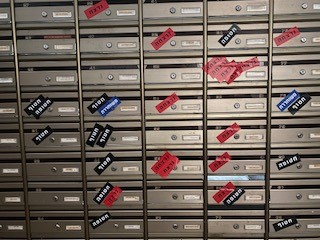
Amit told us about the 23 hours she spent with her husband and 4 children in their safe room, listening to the noise of machine guns and explosions. She recalled the tumult of the terrorists in her home, how they had no water, no food, no air. Her children were hungry; it was frightening. She tried to stay in touch with her mother and brother who also lived on the kibbutz using their family group chat – and they did for several hours the morning of October 7th – until there was silence. Her mother and her brother and his family were dragged out of their safe rooms and murdered by the terrorists.
Amit brought us inside her home. It was burned out and is uninhabitable. Her children aren’t sleeping. She is currently living in a temporary home. She feels she can never bring her children back to Nir Oz. She doesn’t know what she’s going to do.

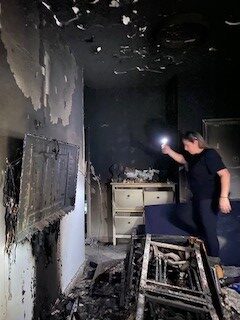
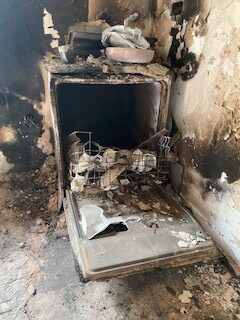

Nili was kidnapped from the safe room in her home by two young terrorists. Her abductors found her car keys and told her to take them to her car. She did, hoping they’d take and car/leave her alone. Instead, they wrapped her in a sheet and bundled her off to Gaza where they sold her to a group from Hamas. She was imprisoned in a tunnel in Gaza for 55 days. No fresh air, no daylight. A bowl of rice and half a piece of pita bread a day to eat.
Nili was a pediatric nurse who cared for both Israeli and Arab children. Because of that, Nili understood what her captors were saying. She was responsible for caring for 7 elderly men, also kidnapped from Kibbutz Nir Or. Nili explained the terrorists took the men’s eyeglasses and hearing aids away. This made the trek through the tunnels much more difficult. The medicines that were requested/provided by the Red Cross for the hostages with medical conditions were stolen by the terrorists. They played tapes of people begging for help and children crying to demoralize her. Amir Bibas, was being held with Nili. He was forced to make a propaganda tape which was widely circulated. Amir’s 2 children and wife (the Bibas family) were also kidnapped and their fate/location is still unknown. Nili said the only thing that kept her alive was that she was useful to her captors. She feels she lived through this because she was busy all the time taking care of the other hostages. She doesn’t know what happened to her fellow captives.
After Nili was released, she went to her home at the kibbutz and found it was totally destroyed. Everything she owned was gone. She only had the clothing she was wearing. I don’t know how she was able to share this with us without breaking down.
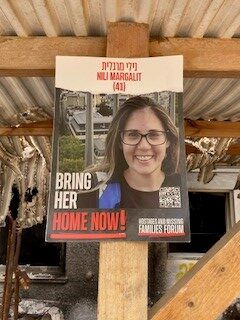

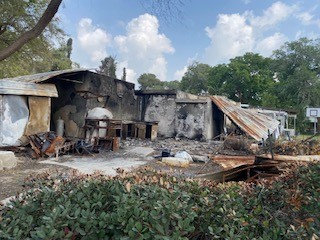

We went to the Re’im Forest, site of the Nova Festival massacre where hundreds of young people celebrating a festival of music and peace were violently killed, machine gunned down, burned to death. Women were sadistically gang-raped and mutilated.  The terrorists threw grenades into bomb shelters, killing everyone they could. More than 70 people crammed into the bomb shelter below and were murdered. We heard stories of bravery. A young man catching grenades that were thrown into the shelter and throwing them back out. Until he one blew. And he was murdered.
The terrorists threw grenades into bomb shelters, killing everyone they could. More than 70 people crammed into the bomb shelter below and were murdered. We heard stories of bravery. A young man catching grenades that were thrown into the shelter and throwing them back out. Until he one blew. And he was murdered.
Tributes to the dead have sprung up throughout the festival site, memorializing the lives of so many lives cut short. Trees were planted for the victims. People created shrines for their loved ones with photos; Yizkor candles, personal touches. When we visited the site, a group of men had formed a circle around a man with a guitar. They were singing psalms and praying. This added to the sanctity of the place.

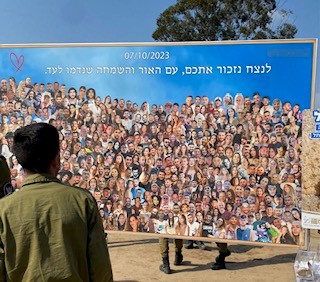
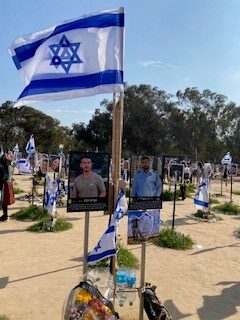

I think the death toll that night was 400. That’s a huge number of people horribly slaughtered. But each of the people who were killed was a unique individual. I want to share the stories about a few I learned about.
Maya Puder. We met her mom and dad in Zichron Yakov. Maya was murdered as she was running away from the terrorists who invaded the Nova festival. Maya was 25, an aspiring actor and director, and IDF volunteer. She went to the festival with friends. Below is her photo.
Arik was also murdered at the Nova festival. He was killed by a grenade thrown into the bomb shelter which was packed with other young people desperately hoping for safety. His mother told me he saved 3 of his friends.
I met Arik’s mother, Gemla, at the Healing Center in Sitria where she goes three times a week to be with people who understand what she is going through. Before she found the Healing Center, she was barely eating or leaving her apartment.
Arik was 28. Gemla told us he was a kind and gentle soul who loved ceramics. Gemla let me copy these pictures of Arik from her phone.

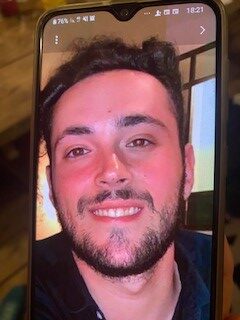

T
This Healing Center is volunteer-run. It is in the backyard of Einat Haimovitz and Yiftach Shahar, who created this warm, inclusive place to give Nova survivors and their families an opportunity for companionship and community. I was so impressed with the warmth and honesty of this healing center. It gives off a kind of 1960’s peace & love vibe.
Two survivors of the Nova Massacre also joined us to talk. They didn’t give us specifics of their experience and we didn’t ask. But they both said that they have taken advantage of therapy programs and that they are trying to cope with what they saw, what happened to their friends. They say they will never be the same. I also met

the mother are sister of Guy Aziz, a fashion designer who lived in Tel Aviv. He was murdered at the festival along with the group of friends he went with. His sister asked me to remember his name.
Yossi Landau, pictured below, is an officer with ZAKA. ZAKA is a series of voluntary community emergency response teams in Israel. The full name is “ZAKA – Identification, Extraction and Rescue – True Kindness. ZAKA is the organization that handles proper Jewish burials. He spoke with our group. Yossi exudes experience, competency, toughness and tenderness. As a first responder to the Nova Massacre scene, he was overwhelmed by the carnage and the sheer sadism of the murders. Yossi explained that Zaka had never experienced so many dead before. Respectfully processing the bodies for burial took precedence. 
Yossi also said that the terrorists were surprised by the Festival (it wasn’t in their plans) and it distracted them from over-running some of the other kibbutzim, moshavim and towns in the area. Their deaths may have saved thousands of people from the Hamas invasion.
The parents of Adi Vital-Kaploun told us their story. Adi and her 2 sons, Negev (3 ½) and Eshol (6 months) were sheltering in their home in Kibbutz Holit. Her husband was not at home at the time. The morning of October 7th, Hamas terrorists entered the kibbutz and began going from house to house, slaughtering innocent civilians, some of them entire families. Adi was hiding in her shelter with her 2 children while Adi’s father was hiding in a shelter in the house across the way. The terrorists shot Adi dead in front of her children. Adi’s father was across the street in the Kibbutz guesthouse. He was in the safe room there and heard the shots and peered out the window.  He saw the terrorists pull a neighbor, Avital, out of her safe room. Then, they herded Avital, Negev and Eshol out of the Kibbutz and towards Gaza. The terrorists filmed a propaganda video before abducting them. Adi’s mother explained that Negev had been injured and screamed and protested the whole way. At some point, the terrorists abandoned the children and Avital, and they were able to escape back to the kibbutz. Adi’s body was shoved under Negev’s bed and booby-trapped so it would explode if anyone tried to move it. Fortunately, when Adi’s husband found her, the bombs didn’t go off.
He saw the terrorists pull a neighbor, Avital, out of her safe room. Then, they herded Avital, Negev and Eshol out of the Kibbutz and towards Gaza. The terrorists filmed a propaganda video before abducting them. Adi’s mother explained that Negev had been injured and screamed and protested the whole way. At some point, the terrorists abandoned the children and Avital, and they were able to escape back to the kibbutz. Adi’s body was shoved under Negev’s bed and booby-trapped so it would explode if anyone tried to move it. Fortunately, when Adi’s husband found her, the bombs didn’t go off.
Adi’s mom let me copy this photo off her cell phone.
She said that Negev and Eshol are living with their father, Anani. Her parents have created a fund in Adi’s memory to help with expenses for therapy, rebuilding. Negev saw hi mother being shot – his grandmother explained that he is the only person who knows the real story of what happened to them.
I want to talk about the remaining hostages. 145 Days. 145 Days in darkness, captivity, uncertainty. 145 where families don’t know what happened to their loved ones.

Hostage Square has many art installations reminding us all that there are 130 hostages still at risk in Gaza. This is the location of the white-linen covered Shabbat table with empty chairs. Each chair has a poster of a hostage. Another artist added a long table with a gray tablecloth, dirty water in a chipped glass and half a piece of pita bread at each place setting to show what the hostages are eating in captivity. According to our guide Ifrat, new artwork commemorating the hostages continue to spring up.
When our group was visiting, a young girl sat down at a piano in the square and started playing. It was eerie hearing Hatikvah being played in the background, the notes in the wind.
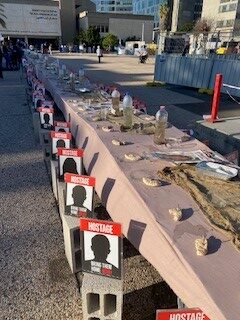
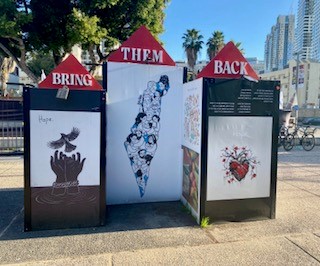


Then we visited the Hostage and Missing Families Forum in Tel Aviv, where we met Itzik Horn. Itzik is 71 and looks much older. Two of his sons, Iair and Eitan were kidnapped and taken into Khan Younis in Gaza. At least that was the location of the last ping on Iair’s cellphone. Itzik lives in Ashkelon north of the Gaza Strip. On the morning of October 7th, both his community and the Kibbutz were under red alert because of rocket fire. They were in their respective shelters. Itzik explained that the terrorists who stormed their kibbutz and kidnapped Iair and Eitan them were actually workers on the kibbutz who were familiar with the layout and the residents. Itzik came to Israel from Argentina in 1992, after the JCC in Buenos Ares was bombed. He is on dialysis three times a week. Itzik’s hope for a needed kidney match is one of his sons.
Itzik thanked us for coming. He wants us to share his story so that the hostages are not forgotten. He fears the longer the hostages are held, the more dire their situations.


Israel is a small country. Most of the population is either related to, or knows someone who was murdered victims, taken hostage, been wounded, displaced or is active duty military. People are traumatized. 200,000 citizens are still in limbo as to when they can go home. Ifrat told us how she dreads the morning news. “We regret to inform you….”. The uncertainty of war hangs over their heads.
On the outside, everyone is going about their days. There is a lot of pain and distress on the inside. We passed lush green fields and you would never know there is a war going on. Until you hear the artillery fire. We were standing at the fence in Kibbutz Nir Oz with Nili and she said you get used to it. I jumped each time. 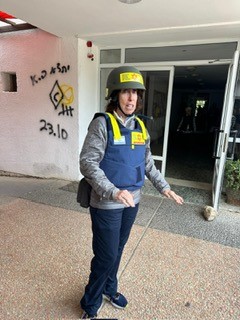 Ifat told us that the body instinctively remembers the sounds of the sirens and reacts any time one goes off.
Ifat told us that the body instinctively remembers the sounds of the sirens and reacts any time one goes off.
On October 8th Israel civil society started to come together to deal with the aftermath of the invasion and massacres. Volunteers sprung into action – feeding soldiers, commandeering hotel rooms for evacuees, starting day care centers and schools, raising money for therapy programs for survivors, creating organizations that actively work with the families of the hostages.
Resilience. That’s the word that comes to mind when I think of Amit, Nili, Gemla, Judy, Yossi, Itzik and Ifrat. Trying to rebuild their lives, their communities, their country. They are courageous and inspiring.
The soldiers we met, the wounded we visited in Shaare Tzedek hospital were amazing. The wounded soldiers were ready to rejoin their companies and go back into the fray as soon as they were healed. Their resilience, dedication and perseverance and was inspiring.
 I hope my retelling of their stories did them justice.
I hope my retelling of their stories did them justice.
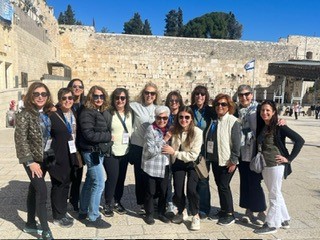

This is incredible! Thank you!❤️
This article touches on a fraction of the pain and suffering endured by Israelis in the Gaza envelope and beyond. Dale you did a tremendous job sharing the experience of our memorable and emotional mission.
Thank you!
Our hearts are broken. So much pain. It’s hard to comprehend the brutality inflicted on our people.
OUTSTANDING RECAP!!! You did a great job documenting some of the atrocities we were able to bear witness and share. Thank you Dale. Hard to fathom the total brutality and horrific acts committed.
Dale, you did an amazing job sharing your experience with us. Your details made me feel like I was there with you and I thank you for bearing witness to these atrocities for us all.
It’s heartbreaking and yet so necessary!! Keep telling and retelling their stories. You are honoring the memories of those lost and honoring those struggling to cope. Thank you for bearing witness. Am Yisrael Chai.